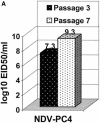Identification of a mutation in editing of defective Newcastle disease virus recombinants that modulates P-gene mRNA editing and restores virus replication and pathogenicity in chicken embryos
- PMID: 12915541
- PMCID: PMC187413
- DOI: 10.1128/jvi.77.17.9259-9265.2003
Identification of a mutation in editing of defective Newcastle disease virus recombinants that modulates P-gene mRNA editing and restores virus replication and pathogenicity in chicken embryos
Erratum in
- J Virol. 2003 Oct;77(20):11299
Abstract
Editing of P-gene mRNA of Newcastle disease virus (NDV) enables the formation of two additional proteins (V and W) by inserting one or two nontemplated G residues at a conserved editing site (5'-AAAAAGGG). The V protein of NDV plays an important role in virus replication and is also a virulence factor presumably due to its ability to counteract the antiviral effects of interferon. A recombinant virus possessing a nucleotide substitution within the A-stretch (5'-AAgAAGGG) produced 20-fold-less V protein and, in consequence, was impaired in replication capacity and completely attenuated in pathogenicity for chicken embryos. However, in a total of seven serial passages, restoration of replication and pathogenic capacity in 9- to 11-day-old chicken embryos was noticed. Determining the sequence around the editing site of the virus at passage 7 revealed a C-to-U mutation at the second nucleotide immediately upstream of the 5'-A(5) stretch (5'-GuUAAgAAGGG). The V mRNA increased from an undetectable level at passage 5 to ca. 1 and 5% at passages 6 and 7, respectively. In addition, similar defects in another mutant possessing a different substitution mutation (5'-AAAcAGGG) were restored in an identical manner within a total of seven serial passages. Introduction of the above C-to-U mutation into the parent virus (5'-GuUAAAAAGGG) altered the frequency of P, V, and W mRNAs from 68, 28, and 4% to 15, 44, and 41%, respectively, demonstrating that the U at this position is a key determinant in modulating P-gene mRNA editing. The results indicate that this second-site mutation is required to compensate for the drop in edited mRNAs and consequently to restore the replication capacity, as well as the pathogenic potential, of editing-defective NDV recombinants.
Figures








Similar articles
-
A recombinant newcastle disease virus with low-level V protein expression is immunogenic and lacks pathogenicity for chicken embryos.J Virol. 2001 Jan;75(1):420-8. doi: 10.1128/JVI.75.1.420-428.2001. J Virol. 2001. PMID: 11119610 Free PMC article.
-
Newcastle disease virus V protein is a determinant of host range restriction.J Virol. 2003 Sep;77(17):9522-32. doi: 10.1128/jvi.77.17.9522-9532.2003. J Virol. 2003. PMID: 12915566 Free PMC article.
-
Newcastle disease virus V protein is associated with viral pathogenesis and functions as an alpha interferon antagonist.J Virol. 2003 Aug;77(16):8676-85. doi: 10.1128/jvi.77.16.8676-8685.2003. J Virol. 2003. PMID: 12885886 Free PMC article.
-
Molecular biology of Newcastle disease virus.Prog Vet Microbiol Immunol. 1989;5:16-64. Prog Vet Microbiol Immunol. 1989. PMID: 2696520 Review. No abstract available.
-
Bipartite promoters and RNA editing of paramyxoviruses and filoviruses.RNA. 2019 Mar;25(3):279-285. doi: 10.1261/rna.068825.118. Epub 2018 Dec 26. RNA. 2019. PMID: 30587495 Free PMC article. Review.
Cited by
-
Nipah virus edits its P gene at high frequency to express the V and W proteins.J Virol. 2009 Apr;83(8):3982-7. doi: 10.1128/JVI.02599-08. Epub 2009 Feb 11. J Virol. 2009. PMID: 19211754 Free PMC article.
-
Genomic sequence of an antigenic variant Newcastle disease virus isolated in Korea.Virus Genes. 2007 Oct;35(2):293-302. doi: 10.1007/s11262-007-0078-z. Epub 2007 Feb 21. Virus Genes. 2007. PMID: 17318427
-
Identification of Newcastle disease virus P-gene editing using next-generation sequencing.J Vet Med Sci. 2020 Aug 28;82(8):1231-1235. doi: 10.1292/jvms.18-0707. Epub 2020 Jul 6. J Vet Med Sci. 2020. PMID: 32624548 Free PMC article.
-
Distinct and overlapping roles of Nipah virus P gene products in modulating the human endothelial cell antiviral response.PLoS One. 2012;7(10):e47790. doi: 10.1371/journal.pone.0047790. Epub 2012 Oct 19. PLoS One. 2012. PMID: 23094089 Free PMC article.
-
Genetic analysis of avian paramyxovirus-1 (Newcastle disease virus) isolates obtained from swine populations in China related to commonly utilized commercial vaccine strains.Virus Genes. 2010 Dec;41(3):369-76. doi: 10.1007/s11262-010-0516-1. Epub 2010 Jul 27. Virus Genes. 2010. PMID: 20661635
References
-
- Beard, C. W., and R. P. Hanson. 1984. Newcastle disease, p. 452-470. In M. S. Hofstad, H. J. Barnes, B. W. Calnek, W. M. Reid, and H. W. Yoder (ed.), Diseases of poultry. Iowa State University Press, Ames.
-
- Buchholz, U. J., S. Finke, and K.-K. Conzelmann. 1999. Generation of bovine respiratory syncytial virus (BRSV) from cDNA: BRSV NS2 is not essential for virus replication in tissue culture, and the human RSV leader region acts as a functional BRSV genome promoter. J. Virol. 73:251-259. - PMC - PubMed
-
- Delenda, C., S. Hausmann, D. Garcin, and D. Kolakofsky. 1997. Normal cellular replication of Sendai virus without the trans-frame, nonstructural V protein. Virology 228:55-62. - PubMed
-
- Delenda, C., G. Taylor, S. Hausmann, D. Garcin, and D. Kolakofsky. 1998. Sendai viruses with altered P, V, and W protein expression. Virology 242:327-337. - PubMed
MeSH terms
Substances
LinkOut - more resources
Full Text Sources

